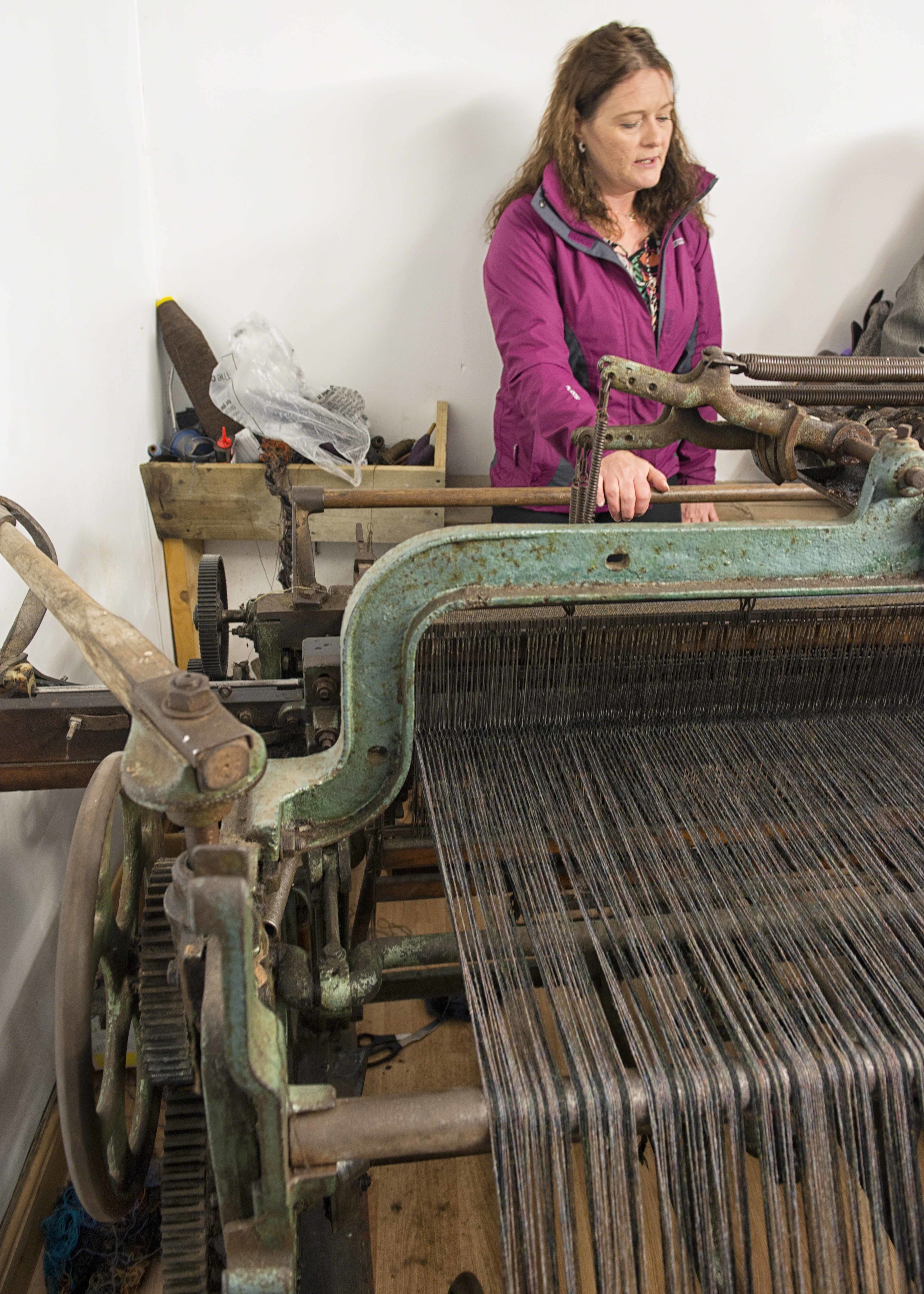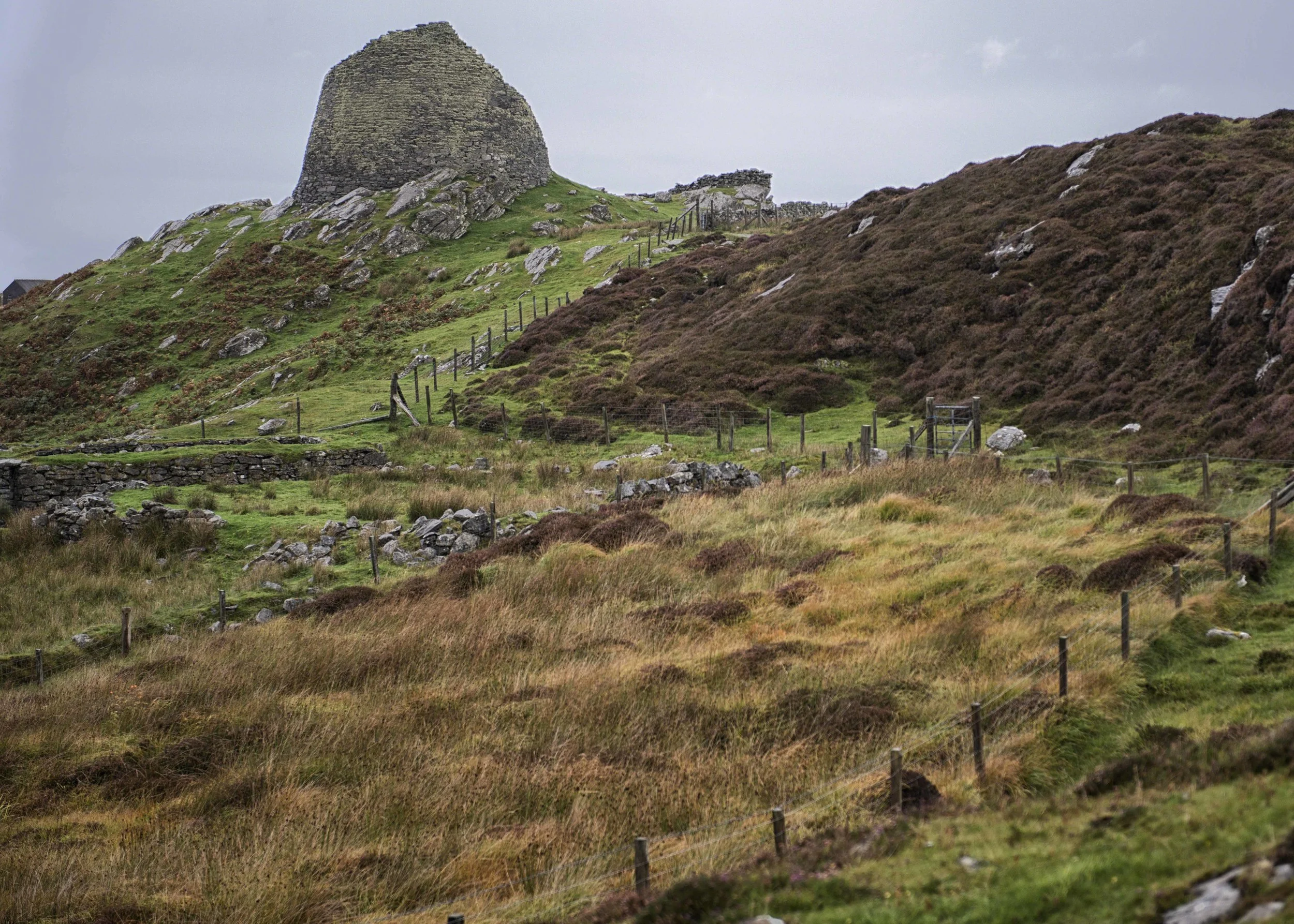
36. The pretty village of Shieldaig lines up along Loch Shieldag, the colors of its houses softly muted.
Shieldag, Strathcarron, Highlands

37. Departing from the handsome coastal town of Oban with late afternoon light adding charm to the water, clouds and buildings.
Oban has a pretty waterfront and a busy harbor with ships coming in from the various islands and coastal locations in the Hebrides as well as from points beyond.

38. Looking down the line of Oban harbor, the delights of the Hebrides await us.

39. Looking back at Oban as we move out to sea with its lights shimmering in the early evening.
Up on the hill above the town, is McCraig's Folly, shown here illuminated at night. It was built by banker, John McCraig, with the intention of making a coliseum. McCraig died before its completion, but it serves the town as a distinctive monument.

40. Looking down the harbor to the Village of Castlebay with Kisimul Castle sturdily defending the approach.
Castlebay sits on the southern part of the Isle of Barra, looking out towards the smaller isle of Vatersay and connected by a narrow causeway to it.

41 . The view from Castlebay towards Vatersay shows this small, isolated farm or croft in local terms.

42. The modern dock at Castlebay on a scrumptious Highland day gives a view of the village.

43. Looking down the harbor in Castlebay towards the MacNeil stronghold called Kisimul Castle.

44. Departing Castlebay with memories of the village and of its beaches, as well as the historic castle.

45. As we depart Castlebay, the rugged hillside and harbor homes make a fetching scene with this yellow boat waiting for its next trip.

46. Tarbert on the Isle of Harris has a pretty narrow harbor where Harris tweeds show off their wares.
While known the world over for their toughness, warmth and durability, the Harris tweed weaving center and shop were modest ones. The weaving of the often complex patterns and plaids are done almost as a crofters craft, on home-based teadle looms, using locally raised and dyed wool. The combinations of threads are woven to form the patterns.

47. Looking at the modern dock and rugged coast line at Tarbert.

48. A weaver shows how the manually operated treadle looms work.
It may take a weaver hours to set up the wools to make the complex patterns. The wools are from Highland sheep and are dyed and made into yarn at local mills. Once setup, a loom may produce as much as 4 meters an hour , a little over 13 feet.

49. A closer look at the yarn setup on the looms showing the characteristic variations in color.

50. The resultant sturdy wool cloth may be in traditional tweeds, checks and plaids.
It is amazing to think of those manually operated looms producing bolts of wool cloth like these with variations in patterns and colors.

51. Colorful plaids are also produced in brilliant and soft shades.

52. The end product may be the traditional tweed sports coats as shown here or more colorful ladies garments.

53. Colorful fabrics in jackets, tops, capes and skirts from Harris Tweed.

54. From Tarbert on Harris we sailed north to Stornaway on the Isle of Lewis to see some of its ancient stone artifacts.

55. Callenish Standing Stones on the Isle of Lewis is an impressive Stone Age legacy.

56. Likewise Dun Carloway Broch towers over the countryside of Lewis
For more on the Callenish Standing Stones and Dun Carloway Broch, see the section on Historic Sites.

57. Stornaway has interesting buildings and shops, such as the Old Town Hall shown here.

58. No port is complete without its seagulls, like this one at Stornaway.

59. Stornaway is home to Lews Castle, part of the Stornaway Trust.
Built in the mid-19th century the Castle was constructed on the site of the late 17th century Seaforth Castle.

60. Departing Stornaway, with a view of the Amish Point Lighthouse.
A fabrications plant sits behind it.

61. The fishing village of Shieldaig from a hill overlooking the village.

62. Departing Shieldaig, a village of 85 persons, pretty, yet dwarfed by rugged hillsides.

63. The small village of Plockton is more harbor than village.
The boat seems to be waiting for the tide and its owner to slip out for a fishing adventure.

64. Island and coastal villages often center around the sea, whether for fishing, transportation or incoming visitors.
Plockton, the Highlands, Scotland

65. Looking out to sea from a hill over the village of Plockton.

66. As time passed in Plockton, the skies seemed to become more threatening and the landscapes less playful.

67. Still tidal waters give quiet resting spots for boats.
Plockton Harbor in Loch Carron.

68. Plockton Village has neat little homes set in a row along the harbor.

69. Peeking over the graveyard stone wall to the small village church beyond.
Plockton Village. The Free Church in Plockton was purchased by its residents the fall of 2013 to ensure ongoing church services.

70. A second view of the churchyard at the Plockton Free Church.

71. The small village of Inverie has an impressive backdrop of Sgurr Coire Choinnichean, which rises 769 meters (over 2500 feet) behind the tiny village.
It is the only village on mainland Scotland not reachable by road.

72. The former church has been transformed into a handsome residence.
Village of Inverie, The Highlands, Scotland

73. The church turned home looked welcoming in the clearing weather.
Village of Plockton, the Highlands, Scotland

74. Lovely trees line the short walk along the end of Loch Nevis.
Inverie, Scotland

75. Looking across the tip of Loch Nevis to a small outcropping, like a miniature replica of the larger hillside.

76. Looking over the coast rocks into the sun over Loch Nevis and beyond.
Inverie, Scotland

77. Looking back along Loch Nevis to where the Hebridean Princess is anchored.
The day was exquisite with the rough shore line, the rust colored grasses and the shades of blue in the water and the sky.

78. View of the harbor on the walk back into Inverie.

79. A totem pole is an unexpected object to encounter in a Hebridean town. This one was designed by primary school children.
It was carved into a local larch by townspeople, friends and visitors in the summer of 2009 to commemorate the 10th anniversary of the community's buy-out of Knoydart as the area is called.

80. Closeup of the totem pole shows the carvings and the bolt and nail studs that decorated parts of its surface.
Inverie, Scotland

81. Tobermory is a colorful town on the Sound of Mull with an enchanting harbor and waterfront.
The day was one of blue skies and remarkable clouds, some gray and laden with rain and others white and puffy, offering interesting patterns of light and shadow in the late afternoon.

82. The panorama of waterfront buildings reflected beguilingly as the skies deepened.
Tobermory, Sound of Mull

83. The laden clouds show signs of rain in the distance as a Caledonian MacBrayne ferry steams in.
The Caledonian MacBrayne (Calmac) is the largest operator of ferry transportation between mainland Scotland and 22 of the Hebridian Islands, serving as a lifeline for residents and visitors, bringing passengers, cars and supplies to and from the islands.

84. Another view of the harbor in Tobermory with a ship's anchor in the foreground.

85. Looking out to sea over an old boat and anchors
Tobermory and the Sound of Mull, Scotland

86. As rain clouds grew heavier, a rainbow appeared, ending near the Hebridean Princess.
Tobermory, Sound of Mull, Scotland

87. Within a few moments an echoing rainbow echoed the first, softly visible

88. Looking over the docks and vessels, the proverbial pot of gold appears to be on the decks of the Princess.
Tobermory, Sound of Mull, Scotland





















































